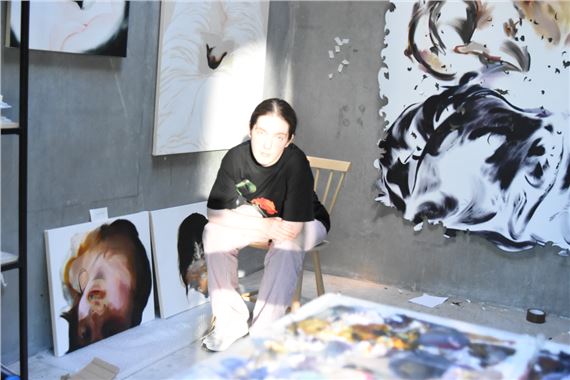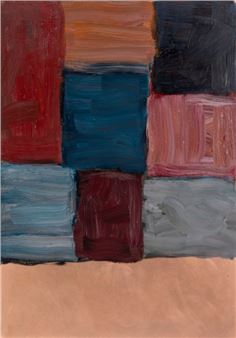Sian Costello: Hot Child
Ormston House is excited to announce Sian CostelloвҖҷs solo exhibition Hot Child. The exhibition will open Thursday, 25 July from 7вҖ“9pm.
Born at the end of the last century, Sian Costello belongs to a generation of artists at the fore of a renaissance in figurative painting. For the past decade, this tendency has been sustained by those who portray the human form as a cradle of sensation, a locus of agency, and a carrier of meaning. That the focus of artists would return to the human body seems inevitable in our virtualised age, in which the concept of what constitutes corporeality вҖ“ and ultimately our very humanness вҖ“ is called into question. Simultaneously, the relationship between desire and physical reality (as opposed to augmented reality) is rapidly changing as touch screens become the site of personal and sexual expression.
A concern with exploring sensuality via paint is tangible in this solo show by Costello. The subjects depicted here, and the means by which they are executed, communicate a libidinal exuberance. Take for example Le Gubbeen I and II (2023), in which fleshy forms writhe in vibrational ecstasy. These two paintings, like several others here, evoke HГ©lГЁne CixousвҖҷ definition of the term jouissance as вҖңpotentially sexual rapture that combines mental, physical and spiritual aspects of female experience, bordering on mystical communionвҖқ. Religious or sexual rapture can also be seen on the face in the evocatively titled Hussey de Burgh. With head thrown back and mouth open in a moan, she evokes the passions of Saint Teresa, as sculpted by Bernini in his baroque tour-de-force.
Looking at the artworks here, one sees Costello has derived pleasure from the process of producing them. In My Own One and Only I and II (2024), recognisable anatomical details are married with gestural abstraction. Tight zones of meticulously-applied paint are situated next to expansive fields where broad, manual sweeps of colour trace the index of the artistвҖҷs expressive motions. Details of hands and faces are worked up against a backdrop of negative space, and in some places, raw canvas reveals itself. A movement away from representation so that areas of compositions teeter into abstraction is a notable development. Discussing this evolution, Costello states it was prompted by ecclesiastical interiors encountered on a recent residency in Denmark. The aesthetic impact of the вҖңpre-Reformation frescoes covered in whitewashвҖқ from which вҖңfragments of stories poke through the sea of white has led me to resist that urge to fill the canvas completelyвҖқ.

Ormston House is excited to announce Sian CostelloвҖҷs solo exhibition Hot Child. The exhibition will open Thursday, 25 July from 7вҖ“9pm.
Born at the end of the last century, Sian Costello belongs to a generation of artists at the fore of a renaissance in figurative painting. For the past decade, this tendency has been sustained by those who portray the human form as a cradle of sensation, a locus of agency, and a carrier of meaning. That the focus of artists would return to the human body seems inevitable in our virtualised age, in which the concept of what constitutes corporeality вҖ“ and ultimately our very humanness вҖ“ is called into question. Simultaneously, the relationship between desire and physical reality (as opposed to augmented reality) is rapidly changing as touch screens become the site of personal and sexual expression.
A concern with exploring sensuality via paint is tangible in this solo show by Costello. The subjects depicted here, and the means by which they are executed, communicate a libidinal exuberance. Take for example Le Gubbeen I and II (2023), in which fleshy forms writhe in vibrational ecstasy. These two paintings, like several others here, evoke HГ©lГЁne CixousвҖҷ definition of the term jouissance as вҖңpotentially sexual rapture that combines mental, physical and spiritual aspects of female experience, bordering on mystical communionвҖқ. Religious or sexual rapture can also be seen on the face in the evocatively titled Hussey de Burgh. With head thrown back and mouth open in a moan, she evokes the passions of Saint Teresa, as sculpted by Bernini in his baroque tour-de-force.
Looking at the artworks here, one sees Costello has derived pleasure from the process of producing them. In My Own One and Only I and II (2024), recognisable anatomical details are married with gestural abstraction. Tight zones of meticulously-applied paint are situated next to expansive fields where broad, manual sweeps of colour trace the index of the artistвҖҷs expressive motions. Details of hands and faces are worked up against a backdrop of negative space, and in some places, raw canvas reveals itself. A movement away from representation so that areas of compositions teeter into abstraction is a notable development. Discussing this evolution, Costello states it was prompted by ecclesiastical interiors encountered on a recent residency in Denmark. The aesthetic impact of the вҖңpre-Reformation frescoes covered in whitewashвҖқ from which вҖңfragments of stories poke through the sea of white has led me to resist that urge to fill the canvas completelyвҖқ.
Artists on show
Contact details


 ARTISTS
ARTISTS










